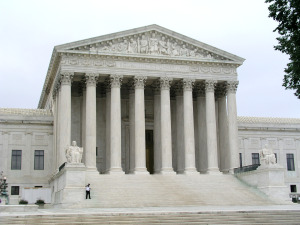
By M. Allie Clayton
On November 15, 2016, the Fourth Circuit released a published opinion in the civil case of United States v. Government Logistics N. V., and held that, while the substantial continuity test for successor corporate liability did not apply, the factual allegations regarding the fraudulent transaction test could not be resolved in this case except by a fact finder, and thus reversed.
Facts and Procedural History
This complex case began over fifteen years ago as a bid-rigging scheme by shipping businesses in order to defraud the United States. The Fourth Circuit has entertained appeals from decisions in this case at three different points throughout the litigation.
This case began in the year 2001, when Gosselin Group N. V. (then known as Gosselin World Wide Moving, N. V.) and at least one other entity, the Pasha Group, implemented a bid-rigging scheme with regard to two government programs—the International Through Government Bill of Lading (“ITGBL”) program and the Direct Procurement Method (“DPM”) program—that facilitate the trans-Atlantic shipping of household goods that belong to military and domestic personnel. The ITGBL program involves the Department of Defense (“DOD”) soliciting bids from domestic freight forwarders, and those domestic forwarders subcontract foreign operations to businesses overseas. The DPM program involves the DOD soliciting bids from international businesses. Both programs were administered by the Army’s Military Transport Management Command (the “MTMC”).
The Gosselin defendants (Gosselin Group N. V., Gosselin World Wide Moving N. V., and Gosselin Group’s CEO and former managing director, Marc Smet) and the Pasha Group (“Pasha”) implemented a bid-rigging scheme in which they increased the prices that the DOD paid to ship goods to and from Europe under the ITGBL and DPM programs. This led to the DOD paying millions of dollars more than it should have paid. Those bid-rigging schemes did not go undetected, and led to the qui tam proceedings in this case, and successful criminal prosecutions. Qui tam proceedings are lawsuits in which a whistleblower brings a civil claim pursuant to the False Claims Act (“FCA”). Under the FCA, 31 U.S.C. § 3730, whistleblowers are rewarded for assisting the United States in recovering any money lost to the defendants, up to 25% of the proceeds if the government participates, and up to 30% of the proceeds if the government does not participate.
The Criminal Prosecutions
In November of 2003, a grand jury returned a two-count indictment against Gosselin Group and Smet that charged each with “conspiracy to restrain trade, in violation of 15 U.S.C. § 1, and conspiracy to defraud the United States, in contravention of 18 U.S.C. § 371.” In February 2004, Gosselin Group and Pasha agreed to be charged and prosecuted by criminal information for the conspiracy offenses. Gosselin Group N. V. and the Pasha Group entered conditional guilty pleas to a pair of criminal conspiracy offenses. Smet signed the plea both for himself and for the Gosselin Group, thereby escaping further criminal prosecution. Pursuant to that plea agreement, both the Gosselin Group and Pasha admitted to various elements of the conspiracy. The plea agreement was accepted on February 18, 2004. As a result of a contemporaneous agreement between Smet and the Army, Smet was barred from doing business with the United States for three years (March 2004-March 2007). A United States Management Team—consisting of four Gosselin Group employees: COO Stephan Geurts St., Stephan Geurts Jr., Timotheus Noppen, and Ludi Bokken—was created within Gosselin Group to allow Gosselin Group to continue working with DOD, in the absence of Smet.
Under the plea agreement, Gosselin Group and Pasha were able to pursue an immunity claim in the district court to seek dismissal of both the charges lodged in the information. The two defendants claimed that the bid-rigging scheme was immune from federal prosecution. In August 2004, the Eastern District of Virginia dismissed one of those charges, finding that certain provisions of the Shipping Act granted Gosselin Group and Pasha immunity from federal prosecution on the antitrust conspiracy. However, the district court also found that the defendants did not have immunity from prosecution on the charge of conspiracy to defraud the United States. Therefore, the two defendants were sentenced only on the latter charge. This decision led to cross appeals from the defendants and the United States. The Fourth Circuit determined that immunity did not apply to either charge, and further held that the defendants were both criminally liable for both conspiracies and remanded to the district court for resentencing. United States v. Gosselin World Wide Moving, N. V., 411 F. 3d 501 (4th Cir. 2005). The resentencing proceedings began in 2006. The district court imposed a $6 million dollar fine on Gosselin Group, and two separate $4.6 million dollar fines on Pasha. The court also ordered both defendants to make restitution to the DOD in the sum of $865,000.
The Qui Tam Proceedings
In 2002, realtors Kurt Bunk and Ray Ammons (the “Realtors”) brought qui tam proceedings against the Gosselin defendants under the FCA. Bunk filed his qui tam action alleging an FCA claim related to the DPM program in the Eastern District of Virginia in August of 2002. Ammons filed his qui tam action alleging an FCA claim related to the ITGBL program (“ITGBL claim”) and to Gosselin Group exerting pressure on Covan International (“Covan claim”) and Cartwright International Van Lines (the “Cartwright claim”) to submit higher ITGBL claims. These cases were sealed, pursuant to 31 U.S.C. § 3730, and remained under seal and pending while the criminal cases were resolved.
Once the criminal proceedings were resolved in 2006, the Department of Justice (“DOJ”) gave the Gosselin defendants notice of the two pending qui tam actions. The DOJ not only detailed the false claims and bid rigging evidence that was underlying the qui tam actions, but also advised the Gosselin defendants that the United States might intervene. In January 2007, the DOJ sent a settlement demand to the Gosselin defendants.
Smet conveyed his frustration regarding the criminal liability and pending civil matters to Geurts Jr. Later Smet approached Jan Lefebure, the Managing Director of International Freight Forwarding Service—the company that handled Gosselin Group’s commercial exports—with a proposal to move Gosselin Group’s business as it related to the United States to another business entity. Lefebure owned another corporation called Brabiver—described as a “company doing nothing” but that had “a license for transportation or freight forwarding.” Smet proposed to Lefebure a scheme to rebrand and reopen Brabiver and move all of his [a.k.a. Gosselin Group’s] government contracts into Brabiver.
On June 27, 2007, Smet made several interest free loans, totaling over €100,000 to the four principles involved in the Brabiver venture, Noppen, Geurts Jr., Lefebure, and Rene Beckers. The loans were not secured, and only repayable on Smet’s demand, but that never occurred. The next day, Smet’s principles used the loans to purchase shares in Brabiver and formalize the change from Brabiver to GovLog. The very next day, GovLog and Gosselin Group entered into a series of agreements that were memorialized by contracts with terms dictated by Smet, not negotiated, and drafted by Smet’s attorneys and presented by Smet to the GovLog principals. These agreements transferred Gosselin Group’s business with the DOD to GovLog, and also committed GovLog to exclusively use Gosselin Group and its related entities to perform said DOD contracts. In exchange for Gosselin Group’s business with DOD, GovLog did not pay, but promised Gosselin Group a percentage of its future net revenue—“all of those revenues received by GovLog . . . minus the amount of the [services] invoiced by [Gosselin Group] to GovLog in connection with the services provided to GovLog by Gosselin Group and its subsidiaries.” Once GovLog obtained Gosselin Group’s DOD contracts, it began its shipping operations on behalf of Gosselin Group on July 1, 2007—approximately four days after Smet made loans to the GovLog Principals.
GovLog consisted of 20 employees, all but one of whom were previous Gosselin Group employees. Their sole business was signing contracts with DOD and arranging shipping services for DOD, but GovLog was not responsible for any actual shipping, nor did it have any warehouses (GovLog leased warehousing facilities from Gosselin Group). All GovLog actually owned was a couple of automobiles, a chair, and a table. GovLog earned no net revenues during 2007 or 2008, and thus was not obligated to pay any funds to Gosselin Group in exchange for Gosselin Group’s business with the DOD. However, GovLog did pay for the leased warehouse facilities and other services provided by Gosselin Group, which essentially meant that any “money that’s going to GovLog is actually ending up being paid to Gosselin.”
Later that year, on November 7, 2007, Ammons’s qui tam action was transferred to the Eastern District of Virginia and consolidated with Bunk’s qui tam action. In 2008, the Realtors’ complaints were unsealed, but on July 18, 2008 Ammons’s qui tam action was superseded by the government’s Complaint in Intervention under 31 U.S.C. § 3730(b)(2). The government did not intervene in Bunk’s qui tam suit. In the Complaint in Intervention, the government named GovLog as a defendant, and alleged that GovLog was “a successor/transferee in interest of Gosselin [Group].” On October 2, 2008, Bunk filed his Second Amended Complaint, which included GovLog as a named defendant and alleged successor corporation liability claim against GovLog.
The Bunk Complaint pleaded numerous FCA theories of liability against the Gosselin defendants and others. Bunk joined several additional complaints, including a 42 U.S.C. § 1985 claim and state law claims. However, only his DPM claim was not superseded by the government’s Complaint in Intervention. In 2011, the government and the Relators moved for summary judgment on the issue of whether GovLog was liable as a successor corporation of Gosselin Group. The district court severed the claims against GovLog from those against the Gosselin defendants, and then proceeded to conduct a trial to first resolve the claims against the Gosselin defendants.
On July 18, 2011, the jury trial for the Gosselin defendants began on the DPM, ITGBL, and Covan claims. At the close of the government’s case, the district court awarded judgment as a matter of law to the defendants on the ITGBL claim, and submitted the DPM and Covan claims were submitted to the jury. On August 4, 2011, the jury returned a verdict against the Gosselin defendants on the DPM claim and in favor of the Gosselin defendants on the Covan claim. Despite evidence establishing that the defendants had submitted over 9,000 false invoices to the DOD, the district court did not impose any civil penalties, reasoning that such an award would be unconstitutionally punitive (each false claim authorized a minimum civil penalty of $5,500, which would have resulted in a cumulative penalty in excess of $50 million dollars).
Both parties appealed. Bunk challenged the district court’s denial of civil penalties, the government challenged the court’s award of judgment on the ITGBL claim, and the Gosselin defendants argued that Bunk lacked standing. The Fourth Circuit rejected the Gosselin defendants’ standing argument, and directed the court to amend its civil penalties judgment and award $24 million dollars in civil penalties on the DPM claim. The Fourth Circuit also vacated the grant of judgment in favor of the Gosselin defendants on the ITGBL claim and remanded the matter for further proceedings.
Once the claims against the Gosselin defendants were resolved, the district court proceeded to determine the successor corporation liability claims pending against GovLog. The district court initially focused on identifying the applicable legal test for successor corporation liability claim. In September 2014, the district court ruled that application of Carolina Transformer’s substantial continuity test would be inconsistent with the Supreme Court’s decision in Bestfoods. United States v. Carolina Transformer Co., 978 F.2d 832 (4th Cir. 1992); United States v. Bestfoods, 524 U.S. 51 (1998). The court then found that only traditional common law principles governed the issue of GovLog’s liability as a successor corporation.
On November 3, 2014, the Relators and the government moved for summary judgment, relying on the common law’s fraudulent transaction theory of successor corporation liability. Bunk presented two theories of successor corporation liability against GovLog: (1) the substantial continuity theory, and (2) the fraudulent transaction theory. GovLog cross-moved for summary judgment, stating that the theory proposed by the government and the Relators was entirely speculative. On December 23, 2014, the district court granted judgment to GovLog under two theories: (1) neither complaint had properly alleged that GovLog was liable as a successor corporation under any recognized legal theory; and (2) GovLog was entitled to summary judgment for want of a genuine dispute of material fact. The court ruled that the transactions between GovLog and Gosselin Group were not shown to have been pursued with a fraudulent intention because there was “no evidence sufficient to establish any of the recognized ‘badges of fraud’” in regard to the creation or operation of GovLog. On December 29, 2014, the court entered judgment in favor of GovLog. The Relators appealed from the judgment, and the Fourth Circuit has jurisdiction under 28 U.S.C. § 1291.
The Initial Jurisdictional Question
Initially, the Fourth Circuit addressed whether or not the district court had subject matter jurisdiction over Bunk’s successor corporation complaint. The Fourth Circuit found that the court possessed supplemental jurisdiction over Bunk’s claim. Bunk’s FCA claim provided original jurisdiction under 28 U.S.C. § 1331. The question remained whether the successor corporation liability claim revolves around the same central fact pattern as the original FCA claim against the Gosselin defendants. The Fourth Circuit held that GovLog’s successor corporate entity liability is wholly dependent on the Gosselin defendants’ liability. Because the “successor corporation liability question is part and parcel of Bunk’s original qui tam action,” the district court did not err in exercising supplemental jurisdiction on this claim.
The Alleged Errors
The Fourth Circuit had to decide whether or not the district court erred by entering judgment in favor of GovLog on the successor corporation liability issue. Bunk challenged the three rulings of the District Court: (1) that the substantial continuity test is inconsistent with Supreme Court precedent; (2) that Bunk had not adequately pleaded the fraudulent transaction theory; and (3) that the fraudulent transaction theory was without evidentiary support, thus leaving no genuine issue of material fact and entitling GovLog to summary judgment.
Successor Corporation Liability Theories
There are four exceptions from the general rule that a corporation that acquires the assets of another corporation does not acquire its liabilities. Under federal common law, a successor corporation takes on the liabilities of its predecessor if: (1) the successor agrees to assume the liabilities; (2) the transaction is a de facto merger; (3) the successor may be considered a “mere continuation” of the predecessor; or (4) the transaction is fraudulent. United States v. Carolina Transformer Co., 978 F.2d 832 (4th Cir. 1992).
Under exception (3), the mere continuation theory states that liability can pass to the successor if “after the transfer of assets, only one corporation remains.” This is not applicable to Bunk’s case because two corporations were viable after the transfer of assets. However, there was another theory proposed in Carolina Transformer—the substantial continuity theory. Substantial continuity theory allows a court to look at eight factors to determine whether successor corporation liability should be imposed. However, the Supreme Court stated in United States v. Bestfoods that “‘[i]n order to abrogate a common-law principle, the statute must speak directly to the question addressed by the common law.’” United States v. Bestfoods, 524 U.S. 51 (1998) (quoting United States v. Texas, 507 U.S. 529 (1993)). Because the FCA doesn’t speak to successor corporation liability, it has “no impact on the traditional common law principles governing successor corporation liability.” Therefore, the district court did not err in declining to apply the substantial continuity test.
Bunk also relied on exception (4), the “fraudulent transaction theory of successor corporation liability.” Because this was dismissed on a motion for summary judgment, the Fourth Circuit reviewed whether the pleadings were legally sufficient under a de novo standard of review. The Fourth Circuit did not decide whether the heightened standard of pleading in Fed. R. Civ. P. 9(b) applied because the Court stated that even if there was a heightened standard it was satisfied in this case. The Bunk Complaint sufficiently outlined the dealings between GovLog and Gosselin Group that formed a solid foundation for the fraudulent transaction theory. Therefore, the district court erred in dismissing Bunk’s successor corporation liability claim as insufficiently pleaded.
The Fraudulent Transaction Theory
However, because the district court ruled in the alternative that GovLog was entitled to summary judgment on Bunk’s fraudulent transaction theory, the Fourth Circuit had to also address whether the summary judgment award was warranted.
Because direct evidence of intent to defraud is rare, courts have developed recognized “badges of fraud” that constitute indirect and circumstantial evidence. Those “badges of fraud” include; (1) the conveyance is to a spouse or near relative; (2) inadequacy of consideration; (3) transactions different from the usual method of transacting business; (4) transfers in anticipation of suit; (5) retention of possession by the debtor; (6) transfer of all or nearly all of the debtor’s property; (7) insolvency caused by the transfer; (8) failure to produce rebutting evidence when the circumstances surrounding the transfer are suspicious; or (9) transactions in which the debtor retains benefits.
In this situation the court found that the evidence did not simply fail to dispel the required fraudulent intention, but it could easily establish it. The Fourth Circuit found that “[a]t least four of the badges of fraud are readily apparent on the evidence . . .:” (1) inadequacy of consideration; (2) transactions different from the usual method of transacting business; (3) transactions in anticipation of suit or execution; and (4) transactions through which the debtor retains benefits. The consideration was found to be grossly inadequate because, in effect, GovLog paid nothing for the business interests it received from Gosselin Group. The transaction was made in haste and with little input from GovLog or any GovLog owners, and Smet was in control of every facet of the transaction—which is not something that occurs in the usual mode of transacting business. Also, the Fourth Circuit found that a reasonable juror could find that Gosselin Group continued to reap the benefits of the business that it transferred to GovLog. But the most suspicious aspect, according to the Fourth Circuit, was the timing of the transaction. “[T]he temporal proximity of the Gosselin defendants’ being advised of the qui tam actions and the GovLog transaction being consummated suggests that the transaction was made to defraud Bunk and the United States out of civil penalties.”
Disposition
According to the Fourth Circuit, the various factual disputes in this case cannot be resolved by anyone except a factfinder. Therefore, the district court erred in awarding summary judgment to GovLog. The Fourth Circuit vacated the judgment and the case was remanded to the district court for further proceedings.












